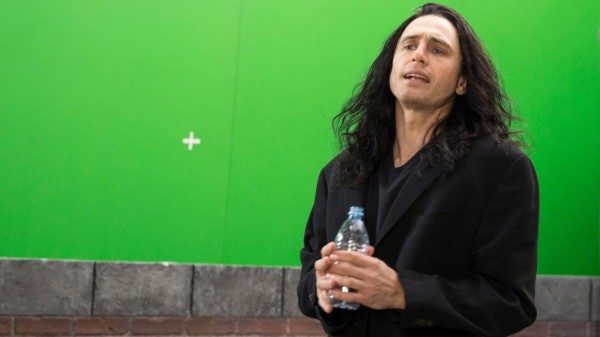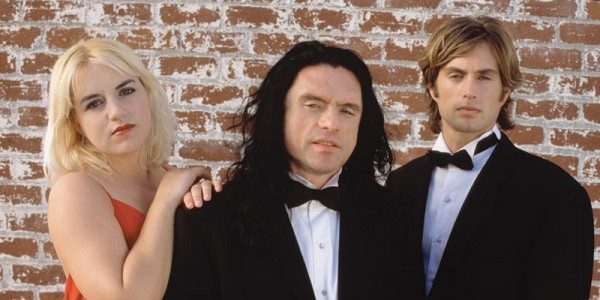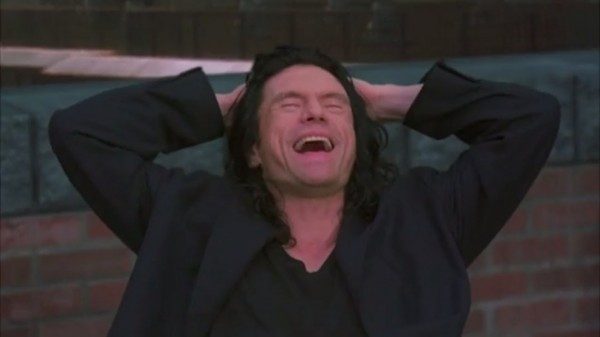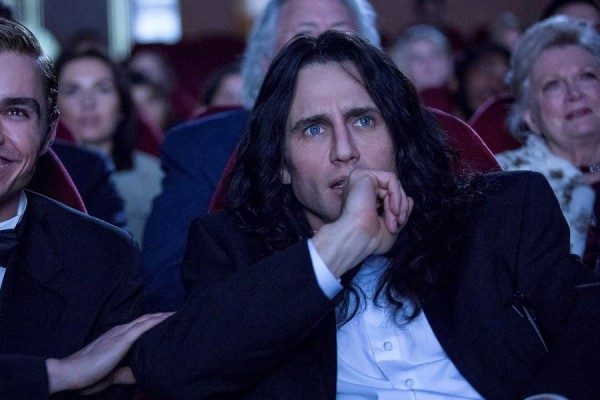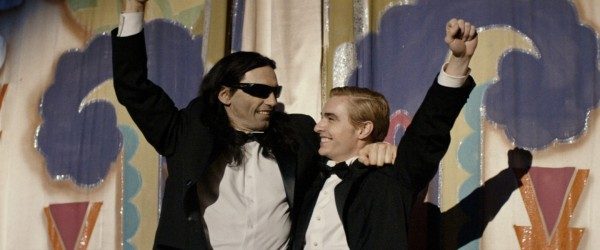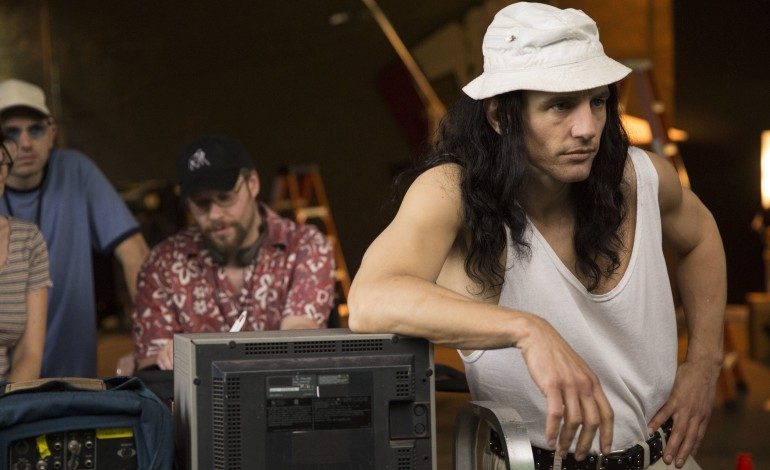

Hollywood is known for big personalities and larger-than-life figures, but arguably no one is as extreme an example of the wildly eccentric Hollywood type than James Franco…except perhaps Tommy Wiseau. Maybe it was fate, then, that brought these two together.
Franco, now a 39-year-old writer/actor/director/artist/scholar, has gained a reputation for starring in major Hollywood blockbusters, earning film and English degrees from an ever-growing list of prestigious schools (including UCLA, Columbia University, Yale University, and the Rhode Island School of Design), teaching film courses, writing short stories and screenplays, designing art exhibits, and directing unconventional multimedia projects (he once re-edited episodes of the sitcom Three’s Company into a multimedia drama which he screened at the Sundance Film Festival).
Meanwhile, Wiseau, a mysterious writer/actor/producer/director, gained notoriety following the release of his 2003 feature debut, The Room, which gained cult status as one of the worst films ever made. Today, Wiseau shows up and speaks at several of the popular midnight screenings of The Room held all over the world, sometimes appearing with his friend and costar, Greg Sestero.
Last Friday saw the release of The Disaster Artist, a biopic directed, produced, released by, and starring Franco. The movie is based on Sestero and Tom Bissell’s acclaimed 2013 book of the same name, which detailed Sestero’s experience making The Room. In the movie, Franco portrays Wiseau, while his younger brother Dave plays Sestero. The actors reportedly consulted extensively with the real Sestero and Wiseau in order to guarantee an accurate representation of their friendship and filmmaking endeavors.
Remarkably for a movie documenting the production of a historically awful film, The Disaster Artist has received near-universal critical praise, specifically concerning Franco’s honest performance as Wiseau. The movie has now earned Golden Globe nominations and is even sparking Oscar buzz.
Franco has stated that his commitment to doing Wiseau and Sestero’s story justice came from the fact that he recognized similarities between Wiseau and himself. Specifically, he noted Wiseau’s undeniable passion for filmmaking and his tireless determination to break into Hollywood, struggles to which Franco can relate. Indeed, watching the movie, one can’t help but feel that the reason it all works so well is because Franco and Wiseau are, in a bizarre way, kindred spirits.
Both Franco and Wiseau started on the path to Hollywood in the late 1990s. After dropping out of UCLA to pursue acting and studying at the Playhouse West under Robert Carnegie, Franco started auditioning in Los Angeles. He landed his first paid role in a Pizza Hut commercial, and finally received a break in 1999, when he was cast in a lead role in the acclaimed yet short-lived NBC series Freaks and Geeks. Soon after, Franco expanded into film with roles in Never Been Kissed and Whatever It Takes.
Meanwhile, Wiseau started taking acting lessons in San Francisco and met Sestero in one such class in 1998. The two developed an unlikely friendship. Though Sestero was confused by Wiseau’s overly dramatic performance style and mysterious personality, he was impressed with his sheer bravery onstage.
They eventually moved to Los Angeles, where they lived together in an apartment Wiseau owned (the source of his vast personal wealth remains a mystery to this day). While Sestero managed to sign with an agent, pick up minor acting credits, and meet new friends, Wiseau’s unidentifiable accent and unusual appearance made it difficult for him to find success. He grew jealous of Sestero, and tension developed in their friendship.
As the new millenium began, Franco received his first notable reviews playing the title role in Mark Rydell’s TV movie James Dean. For the 2001 film, Franco completely immersed himself in Dean’s world, meeting with former associates of the late actor, repeatedly watching his films, reading biographies, taking up smoking, and even cutting off communication with friends and family members in order to capture the essence of the cinema icon.
Interestingly, both Wiseau and Sestero were also inspired by James Dean. Wiseau obsessively watched the actor’s films and even included bits of dialogue from these movies in his screenplay for The Room. The movie’s famous line, “You’re tearing me apart, Lisa,” was pulled from a scene in Dean’s Rebel Without a Cause.
These influences are included in The Disaster Artist, where James and Dave Franco’s characters are shown watching Dean’s films and reenacting scenes. It must have been odd for Franco to play a character obsessed with Dean after earlier playing Dean himself, but perhaps his own obsession with the actor matched Wiseau’s, leading to an even more convincing performance.
2002 was a seminal year for both Wiseau and Franco. The former began production on The Room, which he had earlier written as a play and then a 500-page novel before deciding to turn the story into a screenplay. The concept originated as Wiseau’s attempt to produce a work with the same emotional impact as many of the movies that he and Sestero admired.
He was particularly inspired by 1999’s The Talented Mr. Ripley, a film that Sestero had shown him because the dangerously obsessive and mysterious titular character reminded him of Wiseau. Wiseau missed Sestero’s intention and instead marveled at the high drama of the film, deciding to create a story of his own that would carry the same dramatic weight. The result was The Room, which in many ways mirrors the plot of Ripley, featuring a love triangle and a backstabbing best friend. Though he found the script incoherent, Sestero agreed to help Wiseau produce the film, and thus the endeavor began in 2002.
The production was famously troubled, with Wiseau firing several members of the cast and crew, demanding that actors deliver illogical lines, and relying on script supervisor Sandy Schklair to direct scenes on several occasions due to his inability to focus on both acting and directing at once. Multiple scenes were re-written on set, and Wiseau even unexpectedly replaced the actor playing Mark, a lead role, with Sestero himself on the first day of principal photography. As the shoot began to wind down, actors lost their enthusiasm and began to hope that nobody would ever see the troubled film.
At the same time, Franco was auditioning for what could be the biggest performance of his life: the title role in director Sam Raimi’s Spider-Man. Initially a front runner for Peter Parker/Spider-Man, Franco ultimately lost the part to Tobey Maguire.
What seemed like a failure soon proved fortuitous. The filmmakers eventually decided that they liked Franco enough to include him in the movie. He was cast as Peter’s best friend, Harry Osborn. Winning a significant supporting role in a big-budget film appeared to be a promising step toward mainstream success.
Still, there was a degree of uncertainty attached to the film. While Franco was thrilled to be working with Raimi, superhero movies were not necessarily seen as respectable work, as many efforts at translating comic book characters to the screen throughout the 1990s had failed miserably. Franco’s Spider-Man co-star Willem Dafoe was initially criticized by peers for accepting a role in a superhero film, which they felt was beneath him.
Fortunately, naysayers were proven wrong when Spider-Man received an overwhelmingly positive critical reception and earned more in its first weekend than any other film to date. It helped to usher in the golden age of superhero cinema and propelled Franco and his castmates to stardom.
In the years that followed, Franco starred in movies both major (City by the Sea, in which he acted opposite Robert De Niro) and minor (actor/director Nicolas Cage’s critical and commercial flop Sonny), building a reputation as a skilled comedic and dramatic performer.
Wiseau experienced success of a different sort. After finally finishing production on The Room, he then arranged for the film to premiere at two L.A. locations, renting a spotlight for one of the theaters and arriving at the screening in a limousine. The film’s reception, however, was not what Wiseau expected.
Intending the movie to be a serious drama with the emotional power of a Tennessee Williams play, Wiseau was shocked when the audience at the premiere sat in confused silence and eventually began laughing at the film’s bizarrely illogical moments. Initially disheartened by the viewer reactions, Wiseau was comforted by Sestero, who convinced him to embrace the movie’s unintentional hilarity and the fact that audiences seemed to thoroughly enjoy it.
Wiseau began referring to The Room as an intentional black comedy rather than a serious drama, and celebrated the fact that audiences genuinely loved it, if not for the reasons he originally intended. In the years since, the movie has been continuously viewed at late-night screenings all over the world, finally turning a profit despite its abysmal opening weekend gross.
Wiseau has been hailed by many as a genius for creating what some have described as, “the Citizen Kane of bad movies.” Sestero gained similar notoriety for his role in the film, and the two are currently collaborating on a feature written by Sestero entitled Best F(r)iends.
Sestero also teamed up with author Tom Bissell to chronicle the making of the film in The Disaster Artist: My Life Inside The Room, The Greatest Bad Movie Ever Made. Published in 2013, the book won multiple awards, prompting the recording of an equally successful audiobook version narrated by Sestero himself.
One of the many fans of The Room who ate up Sestero’s book was James Franco, who was inspired by the true story of the friendship between Sestero and Wiseau. Franco related deeply to their efforts as struggling young artists, and their willingness to do whatever they could to realize their dreams.
Thus, when his friend Seth Rogen’s production company acquired the film rights to The Disaster Artist, Franco stepped aboard as producer, director and star. In order to faithfully portray Wiseau, Franco immersed himself in the man’s life just as he had earlier done with James Dean.
He watched countless hours of behind-the-scenes footage shot during the production of The Room, listened to tapes that Wiseau had recorded while developing The Room’s script in order to perfect his impression of the filmmaker’s unique accent, and consulted with Wiseau himself, as well as Sestero, in order to guarantee authenticity.
Franco eventually convinced his brother Dave to play Sestero in the film, believing that acting alongside someone he had known his whole life was the only way to properly portray the bond between Wiseau and Sestero. Franco even went as far as wearing prosthetics to make himself look like Wiseau, and directing The Disaster Artist in character as Wiseau, which threw some of his co-stars off.
In interviews, some of which include Wiseau himself, Franco has repeatedly expressed his desire to portray the story of The Room as a triumphant tale of friendship and following one’s dreams, despite the risk of failure. He intended to honor Wiseau and Sestero, rather than poke fun at them for the ridiculous film they made.
It is understandable, then, why Wiseau would have been willing to sign his life rights over to Franco. Almost any other filmmaker could have easily portrayed Wiseau as a bizarre and unsuccessful hack who became famous for a spectacular blunder.
In Franco’s hands, he becomes a complex, emotional and sympathetic individual who may have been domineering and manipulative at times, but truly had a vision that he was determined to execute. Curiously, Wiseau decided that Franco would be the right person to play him after seeing the actor in Sonny, one of his most critically-panned movies.
As recent reviews have indicated, the fruits of Franco’s labor are mesmerizing. The Disaster Artist is as much a drama as it is a comedy, receiving praise for honestly presenting both the highs and lows of the relationship between Wiseau and Sestero. It is just as admirable for its miraculously accurate recreations of scenes from The Room as it is for the emotionally complex performances of the Franco brothers.
In a bizarre twist, The Disaster Artist has now earned Golden Globe nominations, which represents an astonishing achievement for a film celebrating the creation of truly terrible cinema (an anti-La La Land, if you will). It seems that while telling the story of the worst movie ever made, James Franco saw beneath its surface what others didn’t: a tale of triumph and friendship in the face of discouragement, and in Tommy Wiseau a fellow dreamer eager to present himself to the world. The fact that Franco has chosen to share his perspective with the rest of us is a gift that anyone, whether a fan of The Room or not, can appreciate.

